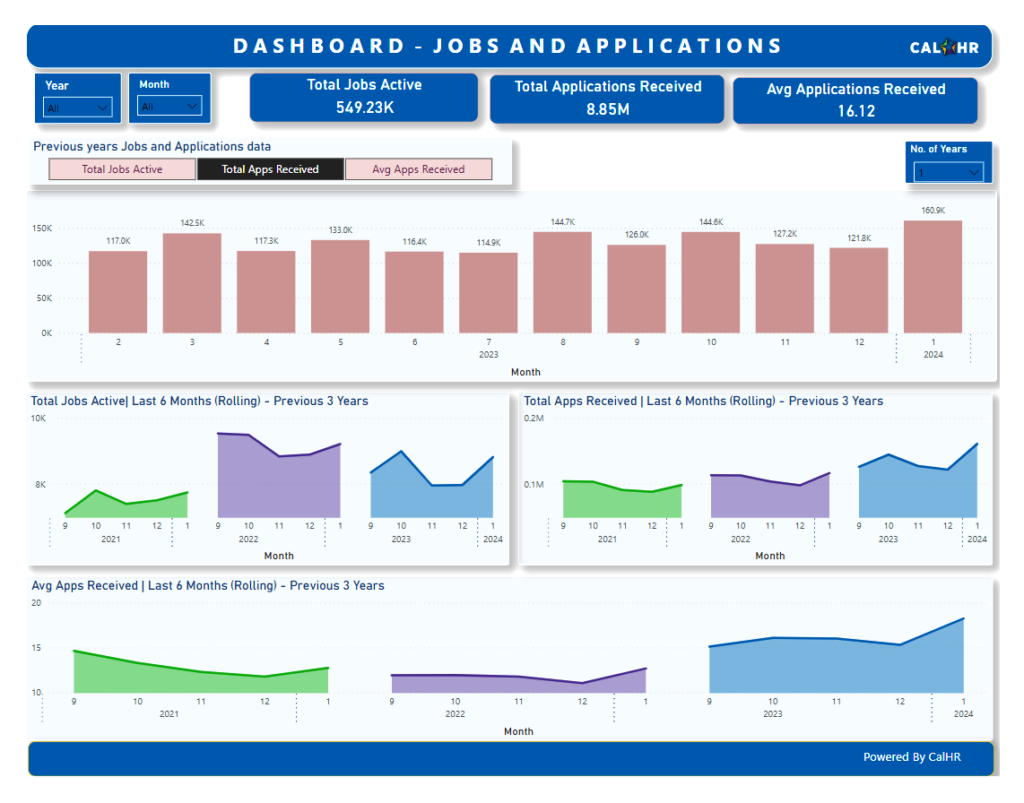Unlocking state hiring insights
We used a modern data pipeline to empower the Department of Human Resources (CalHR) to make data-driven decisions.
Project scope
- Timeline: 4 months
- Team: 3 database administrators, 2 business data analysts, 1 data manager, 1 project manager
- Reach: 1.5 million applications
Partner
Methods
- Automation
- Dashboards
- Data analysis
- Data visualization
- Demographics data analysis
- Equal opportunity analysis
- Journey mapping
The opportunity
The Examination & Certification Online System (ECOS) is a key part of the state recruitment process. ECOS can handle a high volume of hiring-related actions but doesn’t make it easy to analyze the data. CalHR needs to know things like:
- Which job classifications get the most and least interest
- How diverse its candidate pools are across classifications or departments
- If job fairs result in more applications
CalHR used a complex set of manually-run queries to answer their questions. One staff member ran the queries. This process couldn’t scale. It was time-consuming and made it hard to answer key questions about diversity and job interest. The knowledge of ECOS and how to do analysis was siloed.
CalHR wanted to improve their ability to make data-informed decisions.
How we helped
ODI’s Modern Data Stack Accelerator service helps departments improve their data infrastructure. It was a good match for CalHR’s needs. A modern data pipeline would streamline their access to hiring data.
We started by partnering with CalHR to look at ECOS and how staff use it. We found that a modern data pipeline would help CalHR get more out of ECOS. This would make it easier for people to get and use ECOS data.
ODI didn’t just do the work and hand over a solution. As we built the data pipeline, we also trained, mentored, and did pair programming with CalHR staff. These tools and skills gave them the ability to solve future problems.
Our approach
ODI started identifying the end users of ECOS data. We found this wasn’t CalHR IT, our partner team for the project. It was staff across CalHR and the state who analyze and report on hiring data.
This insight focused our work. We made sure our solution gave staff self-service access to ECOS data. This removed bottlenecks from the process.
We made the data pipeline with modern tools and practices. We hosted the pipeline in the cloud. This let us use a modular approach, using only the pieces we needed. Low-code tools made it efficient to move data.
What we built
ODI built a scalable, cloud-based data pipeline. It automatically uses the latest ECOS data to make analysis-ready tables.
The pipeline also improved querying. Queries now go through robust data tests. Staff can see how the queries evolve over time.
Spotlight: dashboards

Program staff now have self-service access to California’s hiring data in close-to-real-time. Staff can use this data to build dashboards, something that took a lot of time before this project.
Impact
The ECOS data pipeline is a proof of concept for how the state can build a modern data pipeline for its hiring data.
Without ODI, CalHR would have had to design every aspect of their approach. This included:
- Conducting market research
- Developing a plan
- Getting stakeholder buy-in
Working with ODI accelerated the process. According to CalHR, just figuring out how to tackle the problem could have taken CalHR years on their own. Instead, the whole project was done in 4 months.
This has moved us years into the future.
—Enrique Parker, Chief Information Officer, CalHR
Modern Data Stack Accelerator
The Modern Data Stack Accelerator (MDSA) service improves departments’ data infrastructure. The MDSA trains departments in a new way of working with data called analytics engineering. All MDSA projects involve data challenges that impact operations. MDSA projects:
- Move data workflows to the cloud
- Emphasize testing, documentation, and continuous development
- Train the trainer so departments can do it themselves going forward
Data and Innovation Fund
This project was part of the Data and Innovation Fund (DIF), one way the Office of Data and Innovation (ODI) helps improve state services for all Californians. ODI works in partnership with the California Department of Technology (CDT), which improves state technology infrastructure through its Technology Modernization Fund (TMF) and Technology Stabilization Service (TSF). Together, these three funds ensure California state departments innovate by applying human-centered design, data, and IT investments to yield quick and meaningful results.
Email info@innovation.ca.gov to learn more about this project.









